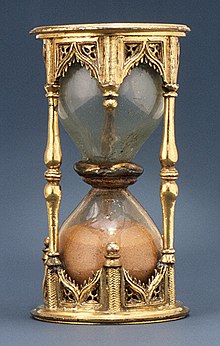
Back ساعة رملية Arabic Reló de sable AST Qum saatı Azerbaijani Ҡом сәғәте Bashkir Пясочны гадзіннік Byelorussian Пясъчен часовник Bulgarian Eurier-traezh Breton Rellotge de sorra Catalan Přesýpací hodiny Czech Piôskòwi zédżier CSB


An hourglass (or sandglass, sand timer, or sand clock) is a device used to measure the passage of time. It comprises two glass bulbs connected vertically by a narrow neck that allows a regulated flow of a substance (historically sand) from the upper bulb to the lower one due to gravity. Typically, the upper and lower bulbs are symmetric so that the hourglass will measure the same duration regardless of orientation. The specific duration of time a given hourglass measures is determined by factors including the quantity and coarseness of the particulate matter, the bulb size, and the neck width.
Depictions of an hourglass as a symbol of the passage of time are found in art, especially on tombstones or other monuments, from antiquity to the present day.[citation needed] The form of a winged hourglass has been used as a literal depiction of the Latin phrase tempus fugit ("time flies").
© MMXXIII Rich X Search. We shall prevail. All rights reserved. Rich X Search